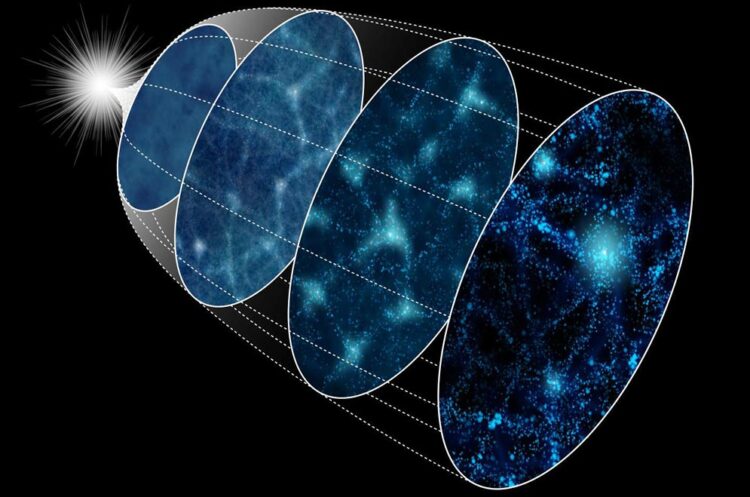Supercomputer turns back cosmic clock

Schematic diagram of the evolution of the Universe from the inflation (left) to the present (right). The "reconstruction method" winds back the evolution from right to left on this illustration to reproduce the primordial density fluctuations from the current galaxy distribution.
Credit: Institute of Statistical Mathematics
Astronomers have tested a method for reconstructing the state of the early Universe by applying it to 4000 simulated universes using the ATERUI II supercomputer at the National Astronomical Observatory of Japan (NAOJ). They found that together with new observations the method can set better constraints on inflation, one of the most enigmatic events in the history of the Universe. The method can shorten the observation time required to distinguish between various inflation theories.
Just after the Universe came into existence 13.8 billion years ago, it suddenly increased more than a trillion, trillion times in size, in less than a trillionth of a trillionth of a microsecond; but no one knows how or why. This sudden “inflation,” is one of the most important mysteries in modern astronomy.
Inflation should have created primordial density fluctuations which would have affected the distribution of where galaxies developed. Thus, mapping the distribution of galaxies can rule out models for inflation which don’t match the observed data.
However, processes other than inflation also impact galaxy distribution, making it difficult to derive information about inflation directly from observations of the large-scale structure of the Universe, the cosmic web comprised of countless galaxies. In particular, the gravitationally driven growth of groups of galaxies can obscure the primordial density fluctuations.
A research team led by Masato Shirasaki, an assistant professor at NAOJ and the Institute of Statistical Mathematics, thought to apply a “reconstruction method” to turn back the clock and remove the gravitational effects from the large-scale structure.
They used ATERUI II, the world’s fastest supercomputer dedicated to astronomy simulations, to create 4000 simulated universes and evolve them through gravitationally driven growth. They then applied this method to see how well it reconstructed the starting state of the simulations. The team found that their method can correct for the gravitational effects and improve the constraints on primordial density fluctuations.
“We found that this method is very effective,” says Shirasaki. “Using this method, we can verify of the inflation theories with roughly one tenth the amount of data. This method can shorten the required observing time in upcoming galaxy survey missions such as SuMIRe by NAOJ’s Subaru Telescope.”
All latest news from the category: Physics and Astronomy
This area deals with the fundamental laws and building blocks of nature and how they interact, the properties and the behavior of matter, and research into space and time and their structures.
innovations-report provides in-depth reports and articles on subjects such as astrophysics, laser technologies, nuclear, quantum, particle and solid-state physics, nanotechnologies, planetary research and findings (Mars, Venus) and developments related to the Hubble Telescope.
Newest articles

Innovative 3D printed scaffolds offer new hope for bone healing
Researchers at the Institute for Bioengineering of Catalonia have developed novel 3D printed PLA-CaP scaffolds that promote blood vessel formation, ensuring better healing and regeneration of bone tissue. Bone is…

The surprising role of gut infection in Alzheimer’s disease
ASU- and Banner Alzheimer’s Institute-led study implicates link between a common virus and the disease, which travels from the gut to the brain and may be a target for antiviral…

Molecular gardening: New enzymes discovered for protein modification pruning
How deubiquitinases USP53 and USP54 cleave long polyubiquitin chains and how the former is linked to liver disease in children. Deubiquitinases (DUBs) are enzymes used by cells to trim protein…


